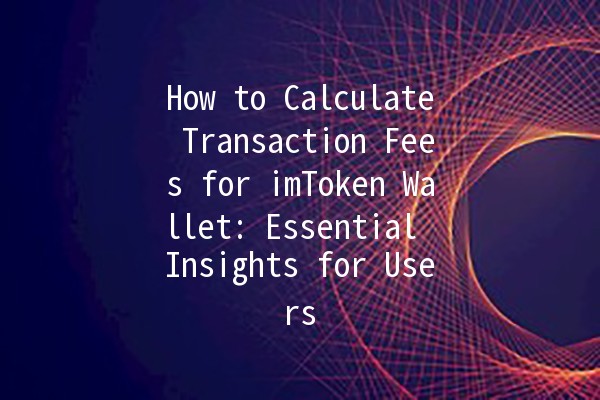In the rapidly evolving world of cryptocurrencies, understanding transaction fees can empower users to make informed decisions. For those utilizing the imToken wallet, comprehending the calculation of transaction fees is crucial, as it can significantly impact the overall efficiency of your cryptocurrency transfers. This article delves deeply into how transaction fees are calculated on the imToken wallet, providing practical tips and techniques for optimizing your transactions.
Transaction fees in the realm of cryptocurrencies are payments made by users to facilitate the processing of transactions on the blockchain. These fees serve multiple purposes:
Several factors influence the transaction fee you will incur when using the imToken wallet:

The imToken wallet simplifies the fee calculation process for users by providing a userfriendly interface. Here's how transaction fees are calculated:
ImToken includes a base fee and a priority fee in its calculations. The base fee covers the cost of processing a transaction, while the priority fee is what a user can set to speed up their transaction during times of high network congestion.
ImToken wallet employs a dynamic fee adjustment algorithm. This means that as network traffic fluctuates, the algorithm automatically suggests a corresponding fee based on current conditions, allowing users to select the most efficient fee level for their transaction urgency.
Here are five actionable strategies to help users minimize transaction fees while still ensuring timely transactions:
Time your transactions during offpeak hours. Research shows that cryptocurrency trading often slows down during weekends and latenight hours (UTC). Executing your transactions during these times can help reduce cost.
Example: If you frequently trade on weekdays, monitor transaction patterns and consider switching to weekends for significant trades.
If you need to send multiple transactions, batching them into a single transaction can be costeffective. This reduces the overall data size and helps minimize fees.
Example: For users sending tokens to multiple friends, instead of sending three separate transactions, use a batch feature if available.
Leverage fee recommendations provided by the imToken wallet. These suggestions factor in current network conditions, allowing users to balance urgency and cost.
Example: Before confirming a transaction, examine the recommended fee tier—low, average, or high—to determine how quickly you need the transaction to be processed.
Regularly check network congestion using tools or trackers online. This information can help users decide when to initiate transactions.
Example: Websites like EthGasStation provide realtime updates on Ethereum network congestion, which can aid decisionmaking for Ethereumbased transactions.
If you are using decentralized exchanges or DeFi platforms, investigate if they offer cheaper alternatives for swapping or trading assets. Some platforms may have integrations with imToken for reduced transaction fees based on their liquidity.
Example: A user might discover that using a specific DEX offers lower transaction fees on imToken compared to another platform.
Transaction fees can vary widely based on blockchain and network conditions. Typically, users might see fees ranging from a few cents to several dollars for Ethereum transactions, depending on network congestion and transaction complexity.
To secure the lowest fees, stay updated on network conditions, utilize recommended fee settings, and consider timing your transactions accordingly, especially during weekends or late nights.
In general, transaction fees are not refundable if a transaction fails on the blockchain. The fee is paid to miners for their processing time, regardless of the transaction outcome.
While imToken does not impose a specific minimum transaction fee, users can find that blockchains, particularly Ethereum, operate with a minimum fee based on network protocols.
imToken assesses transaction fees based on its fee recommendation system, which uses data from the blockchain network regarding current congestion levels and average fees from recent transactions.
Yes, fees may differ when sending Ethereum and ERC20 tokens, as ERC20 transactions can involve additional data, such as contract information, potentially resulting in larger fees.
Understanding and calculating transaction fees in the imToken wallet can seem daunting, but with the right strategies and insights, users can effectively manage and optimize their transactions. By employing the suggested tips, users can not only save on costs but also ensure their transactions are processed efficiently. Staying informed about network conditions and utilizing the features that imToken provides are essential to enhancing your overall cryptocurrency experience.